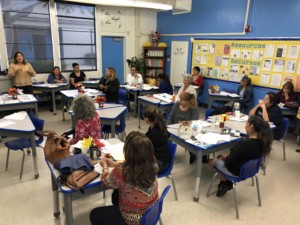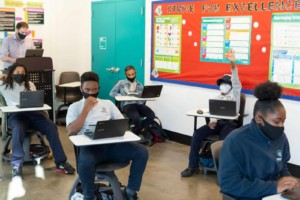Active Parent Engagement and the Role of Digital Portfolios

By: Wanny Hersey
We know that parental involvement strongly impacts student achievement, but what do we mean when we talk about active parent engagement? Are we engaging parents when we send out a newsletter, or point them to a website or even a portal?
Parents often know more about what their second cousin did on vacation via social media than how their own child is doing at school. What if schools could engage parents in real-time and connect them more meaningfully to the dynamic happenings in their children’s classrooms?
In 2015, parent communication was identified as an area for improvement through our annual parent survey. As a school that focuses not just on academic achievement but also on the 21st-century skills and social-emotional growth of our students, clearly just giving parents a static snapshot of where their child was three times a year was not sufficient nor did it adequately capture the learning that was taking place every day in the classrooms.
In addressing this concern, we searched for a solution that:
1. would keep parents informed in a timely manner, ideally using a platform that was both user-friendly and engaging, and
2. didn’t burden our teachers with meaningless work.
Becoming a Partner in the Learning Journey
As a parent, I know first-hand how cumbersome and time-consuming accessing a parent portal can be and how it can add yet another destination to our digital lives. I wanted a platform that gave parents a window into their children’s classroom so that they could regularly see and experience how their children were learning and growing.
With a plethora of educational apps on the market, as an administrator, I am also cognizant that what a school chooses to adopt cannot just address a student and/or parent need, but should be as useful and meaningful for teachers as well.
With all this in mind, and after much searching, we implemented a portfolio and assessment platform called FreshGrade because it enabled teachers, parents, and students to engage in the learning conversation in insightful and authentic ways. The digital platform was easy to introduce to my staff. Most crucially, it was also easy for parents to learn and understand. Rather than having to rely on parents finding the information themselves, they can download an app on their phone or tablet. Parents can immediately comment on an artifact that has been added to the portfolio in mere minutes after it is posted, whether it is a sheet of math homework that showed how a learner carefully sought multiple paths to a solution, a video of a project-based learning collaboration session or a photo of a series of prototypes of a design. These artifacts were no longer confined within the walls of our classrooms but were now instantly viewable to families.
Before we implemented the digital portfolio platform, parents often wondered whether and how their child had improved. Now, through the body of work posted to student portfolios, we can show progression in ways that we were never able to before.
Increasing Student Ownership
To our delight, implementing digital portfolios not only made us more effective in our communications, but it also supported students’ engagement and ownership of their learning. Today, we see Bullis Charter School students taking videos and snapping pictures of learning artifacts that highlight work towards their goals. These artifacts include, but are not limited to, complex math problems with clearly explained solutions, student-generated charts that document class participation, checklists that highlight the editing and revising phase of the writing process, or a recording of a read-aloud that shows improved fluency and expression.
When teachers comment on student work, students respond, which creates a feedback loop between teacher and student and encourages self-reflection. We can see BCS students project a growth mindset within their portfolios as they document how each artifact shows progress towards their goals while carefully laying out the next steps that will be documented in future updates. Parents can view these comments and are immediately invited to engage with their child and the teacher, which not only increases their visibility into the classroom but provides them with opportunities to support their learners at home.
As students built and added to their portfolios, they were able to look back over the course of their work and identify how their learning grew and progressed over time. It was not unusual for students to write comments such as “I can’t believe how much I’ve improved my descriptive writing in my stories,” or, “my classmates tell me that I’m much a better collaborator.” Bullis students are taught to continually self-reflect and analyze their work for improvement opportunities, and digital portfolios play a big role in organizing that process.
Deepen the Conversation About Learning
As we started to share student learning with our families, we noticed that engagement with families increase. The relationship between teachers and parents improved, the tone of their conversations became more positive and proactive, and families became actively engaged in supporting their students and the teachers in the work that was occurring in the classroom. By using online portfolios, we strengthened the Bullis Charter School (BCS) learning community and connected all of our stakeholders to this amazing work.
Where do we go from here? When you start seeing parents engage in their child’s learning, it can be tempting to say, “we did it” and pat yourself on the back. For our school, the next step is improving what we were starting to see.
Encouraging parents to comment on their child’s digital portfolio helps reinforce the learning process and increase growth. When parents are first introduced to a digital portfolio, they tend to leave a lot of “good job” or “awesome work!” comments on learning artifacts. While this positive reinforcement might be encouraging, it doesn’t provide the constructive feedback that students need and stunts the feedback loop before it becomes worthwhile. We want our families to provide meaningful feedback and help foster the development of a growth mindset for our learners.
Actively engaging parents means having ongoing, honest, and meaningful conversations (one other resource we’ve found helpful is this set of free parent conversation starters available in English, French Canadian, Korean, Hindi, Chinese, Spanish, and Filipino) about student learning and growth at Bullis Charter School.
For more, see:
- Creating a Culture of Collaborative Family Engagement
- Engaging Parents to Engage Learners: Digital Portfolios Can Make it Happen
- 3 Lessons Learned Building Student Digital Portfolios
Wanny Hersey is the founding superintendent at Bullis Charter School. Connect with her on Twitter at @wahersey.
Stay in-the-know with all things edtech and innovations in learning by signing up to receive our weekly newsletter, Smart Update.





0 Comments
Leave a Comment
Your email address will not be published. All fields are required.